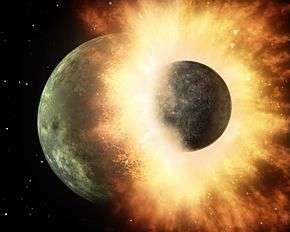Theia (planet)
Theia /ˈθiːə/ or Orpheus (/ˈɔːrfiːəs, ˈɔːrfjuːs/ [1]) is a hypothesized ancient planet in the early Solar System that, according to the giant-impact hypothesis, collided with the early Earth around 4.5 billion years ago, with the resulting debris gathering to form the Moon.[2][3]

In addition to explaining Earth's large moon, the Theia hypothesis can also explain why Earth's core is larger than would be expected for a body its size; Theia's core and mantle mixed with Earth's.[4]
According to one version of the hypothesis, Theia was an Earth trojan about the size of Mars, with a diameter of about 6,102 km (3,792 miles). Additional evidence published in 2019 suggests that Theia might have formed in the outer Solar System rather than the inner Solar System, and that much of Earth's water originated on Theia.[5]
Name
Theia was named for the titaness Theia, who in Greek mythology was the mother of Selene, the goddess of the moon,[6] which parallels the planet Theia's collision with the early Earth that is theorized to have created the Moon.[7]
Orpheus is a legendary musician, poet, and prophet in ancient Greek religion.
Orbit
Theia is thought to have orbited in the L4 or L5 configuration presented by the Earth–Sun system, where it would tend to remain. In that case, it would have grown, potentially to a size comparable to Mars. Gravitational perturbations by Venus could have eventually put it onto a collision course with the early Earth.[8]
Collision

According to the giant-impact hypothesis, Theia orbited the Sun, nearly along the orbit of the proto-Earth, by staying close to one or the other of the Sun–Earth system's two more stable Lagrangian points ( i.e., either L4 or L5).[8] Theia was eventually perturbed away from that relationship by the gravitational influence of Jupiter and/or Venus, resulting in a collision between Theia and Earth.
Computer simulations suggest that Theia was traveling no faster than 4 km/s (8,900 mph) when it struck Earth at an estimated 45 degree angle.
Originally, the hypothesis supposed that Theia had struck Earth with a glancing blow[9] and ejected many pieces of both the proto-Earth and Theia, those pieces either forming one body that became the Moon or forming two moons that eventually merged to form the Moon.[10][11] Such accounts assumed that if Theia had struck the proto-Earth head-on both planets would have been destroyed, creating a short-lived second asteroid belt between the orbits of Venus and Mars.
In contrast, evidence published in January 2016 suggests that the impact was indeed a head-on collision and that Theia's remains can be found in both the Earth and the Moon.[12][13][14]
Hypotheses
From the beginning of modern astronomy, there have been at least four hypotheses for the origin of the Moon:
- A single body split into Earth and Moon
- The Moon was captured by Earth's gravity (as most of the outer planets' smaller moons were captured)
- The Earth and Moon formed at the same time when the protoplanetary disk accreted
- The Theia scenario described above.
The lunar rock samples retrieved by Apollo astronauts were found to be very similar in composition to Earth's crust, and so were likely removed from Earth in some violent event.[12][15][16]
References
- Byrne, Charles (2007). The Far Side of the Moon: A Photographic Guide. Springer. p. 202. ISBN 9780387732060.
- Wolpert, Stuart (2017-01-12). "UCLA study shows the moon is older than previously thought". scitechdaily.com. Retrieved 14 January 2017.
- "The Theia Hypothesis: New Evidence Emerges that Earth and Moon Were Once the Same". The Daily Galaxy. 2007-07-05. Retrieved 2013-11-13.
- "A New Model for the Origin of the Moon". SETI Institute.
- Budde, Gerrit; Burkhardt, Christoph; Kleine, Thorsten (2019-05-20). "Molybdenum isotopic evidence for the late accretion of outer Solar System material to Earth". Nature Astronomy. 3 (8): 736–741. Bibcode:2019NatAs...3..736B. doi:10.1038/s41550-019-0779-y. ISSN 2397-3366.
- Murdin, Paul (2016). Rock Legends: The Asteroids and Their Discoverers. Springer. p. 178. doi:10.1007/978-3-319-31836-3. ISBN 9783319318363.
- "Selene | Origin and meaning of selene by Online Etymology Dictionary".
- "STEREO Hunts for Remains of an Ancient Planet near Earth". NASA. 2009-04-09. Archived from the original on 2013-11-13. Retrieved 2013-11-13.
- Reufer, Andreas; Meier, Matthias M. M.; Benz, Willy; Wieler, Rainer (2012). "A hit-and-run giant impact scenario". Icarus. 221 (1): 296–299. arXiv:1207.5224. Bibcode:2012Icar..221..296R. doi:10.1016/j.icarus.2012.07.021.
- Jutzi, M.; Asphaug, E. (2011). "Forming the lunar farside highlands by accretion of a companion moon". Nature. 476 (7358): 69–72. Bibcode:2011Natur.476...69J. doi:10.1038/nature10289. PMID 21814278.
- "Faceoff! The Moon's oddly different sides", Astronomy, August 2014, 44–49.
- Nace, Trevor (2016-01-30). "New Evidence For 4.5 Billion Year Old Impact Formed Our Moon". Forbes. Retrieved 2016-01-30.
- Young, E. D.; Kohl, I. E.; Warren, P. H.; Rubie, D. C.; Jacobson, S. A.; Morbidelli, A. (28 January 2016). "Oxygen isotopic evidence for vigorous mixing during the Moon-forming giant impact". Science. 351 (6272): 493–496. arXiv:1603.04536. Bibcode:2016Sci...351..493Y. doi:10.1126/science.aad0525. PMID 26823426.
- Wolpert, Stuart (January 28, 2016). "Moon was produced by a head-on collision between Earth and a forming planet". UCLA newsroom. UCLA.
- Herwartz, D.; Pack, A.; Friedrichs, B.; Bischoff, A. (2014). "Identification of the giant impactor Theia in lunar rocks". Science. 344 (6188): 1146–1150. Bibcode:2014Sci...344.1146H. doi:10.1126/science.1251117. PMID 24904162.
- Meier, M. M. M.; Reufer, A.; Wieler, R. (2014). "On the origin and composition of Theia: Constraints from new models of the Giant Impact". Icarus. 242: 316–328. arXiv:1410.3819. Bibcode:2014Icar..242..316M. doi:10.1016/j.icarus.2014.08.003.
